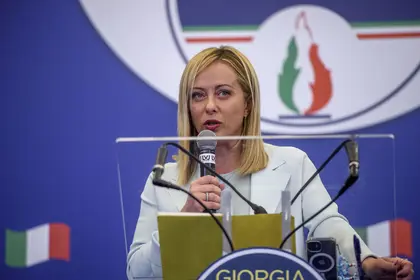Italian Prime Minister Giorgia Meloni confirmed her government’s support for the European Union, NATO and Ukraine on Tuesday, Oct.25, in her first address to parliament, one month after her far-right party won a historic election victory.
The 45-year-old, who was sworn in as Italy’s first woman premier on Saturday, also rejected any links with her country’s fascist past, saying she had “never felt sympathy or closeness to undemocratic regimes… including fascism”.
JOIN US ON TELEGRAM
Follow our coverage of the war on the @Kyivpost_official.
The prospect of a Eurosceptic, populist government leading the eurozone’s third largest economy has sparked concern among Italy’s allies, particularly in the European Union.
“Italy is fully part of Europe and the Western world,” Meloni told the lower house of parliament, adding that it would “continue to be a reliable partner of NATO in supporting Ukraine”.
The last government under Mario Draghi was one of the strongest EU supporters of sanctions on Russia over its invasion of Ukraine, and also sent weapons to Kyiv.
Meloni supported that policy, despite being in opposition — and despite Italy’s heavy dependence at the time on Russian gas.
But one of her coalition partners, former premier Silvio Berlusconi, was recorded last week defending his old friend, Russian President Vladimir Putin.
Meloni said she would not give in to “Putin’s blackmail on energy”.
Like much of Europe, Italy is battling soaring inflation, fuelled by sky-high energy bills, which risks pushing the country into recession next year.
Meloni said she would strengthen existing measures to help businesses and households cope with rising prices, but warned this would have an effect on spending elsewhere.
After her speech, lawmakers will on Tuesday evening hold a vote of confidence in Meloni’s government, the most right-wing in Rome since World War II.
The vote, followed by another in the Senate Wednesday, is largely procedural, as her coalition has a comfortable majority in parliament.
Recovery plan
Before the election Meloni’s coalition, which also includes Matteo Salvini’s far-right League, agreed an expensive programme of tax cuts and spending promises.
But she has emphasised fiscal prudence, wary of Italy’s mammoth debt worth 150 percent of gross domestic product.
She named as economy minister Giancarlo Giorgetti, a relatively moderate member of the League who was economic development minister under Draghi.
Roberto Cingolani, who served as energy minister in the last government, will also stay on as an adviser as Italy weans itself off Russian gas and seeks to boost the use of renewables.
However, even before she spoke to Salvini — her new deputy prime minister and minister for infrastructure — he set out his own costly plan for government.
In a series of tweets late Monday, the League leader vowed action to lower the pension age, extend a flat tax and finally build a long discussed bridge between mainland Italy and Sicily, which he said would create 100,000 jobs.
Key to Italy’s future growth is almost 200 billion euros ($197 billion) in grants and loans from the EU’s post-pandemic recovery fund, which depend on Rome implementing major reforms from criminal justice to public administration.
Meloni said it was an opportunity to make a “real change” but said she would seek “adjustments” to the plan to take into account the rising cost of energy and raw materials.
Analysts say there is little room for manoeuvre, with the funds already being disbursed and Brussels unwilling to re-open negotiations.
Meloni had what she called a “fruitful” first meeting with French President Emmanuel Macron on Sunday in Rome, and spoke on the telephone Saturday with European Commission President Ursula von der Leyen.
Meloni’s Brothers of Italy party won a historic 26 percent of the vote in September 25 elections, with a promise to defend Italy’s borders, traditional values and national interests abroad.
Salvini’s League party won nine percent in the elections while Berlusconi’s right-wing Forza Italia won eight percent.
You can also highlight the text and press Ctrl + Enter



